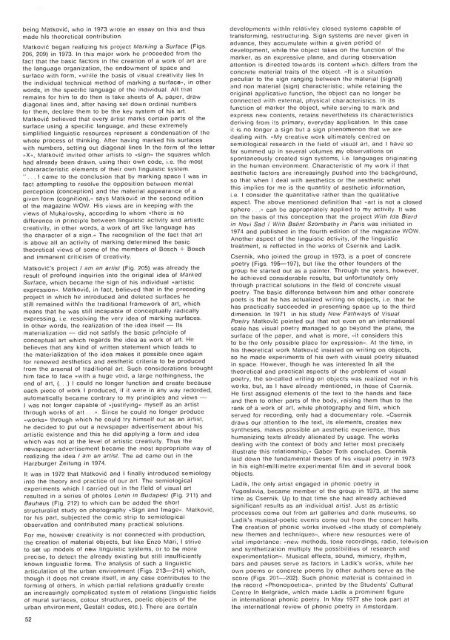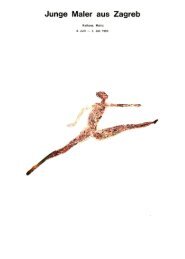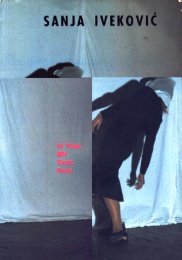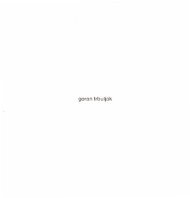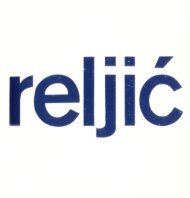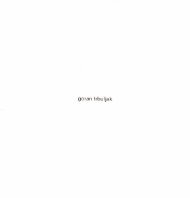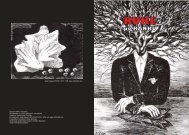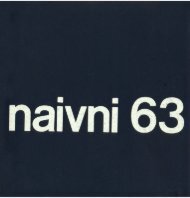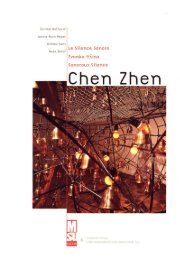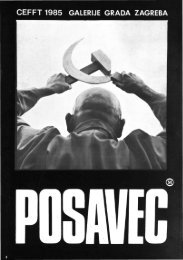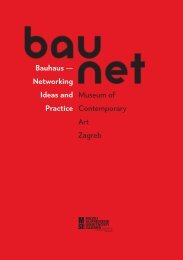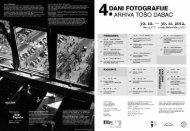The New Art Practice in Yugoslavia, 1966-1978
The New Art Practice in Yugoslavia, 1966-1978
The New Art Practice in Yugoslavia, 1966-1978
- TAGS
- practice
- yugoslavia
- www.msu.hr
You also want an ePaper? Increase the reach of your titles
YUMPU automatically turns print PDFs into web optimized ePapers that Google loves.
e<strong>in</strong>g Matkovi, who <strong>in</strong> 1973 wrote an essay on this and thus<br />
made his theoretical contribution.<br />
Matkovi began realiz<strong>in</strong>g his project Mark<strong>in</strong>g a Surface (Figs.<br />
206, 209) <strong>in</strong> 1973. In this major work he proceeded from the<br />
fact that the basic factors <strong>in</strong> the creation of a work of art are<br />
the language organization, the endowment of space and<br />
surface with form, «while the basis of visual creativity lies <strong>in</strong><br />
the <strong>in</strong>dividual technical method of mark<strong>in</strong>g a surface., <strong>in</strong> other<br />
words, <strong>in</strong> the specific language of the <strong>in</strong>dividual. All that<br />
rema<strong>in</strong>s for him to do then is take sheets of ok, paper, draw<br />
diagonal l<strong>in</strong>es and, after hav<strong>in</strong>g set down ord<strong>in</strong>al numbers<br />
for them, declare them to be the key system of his art.<br />
Matkovi believed that every artist marks certa<strong>in</strong> parts of the<br />
surface us<strong>in</strong>g a specific language, and these extremely<br />
simplified l<strong>in</strong>guistic resources represent a condensation of the<br />
whole process of th<strong>in</strong>k<strong>in</strong>g. After hav<strong>in</strong>g marked his surfaces<br />
with numbers, sett<strong>in</strong>g out diagonal l<strong>in</strong>es <strong>in</strong> the form of the letter<br />
«X., Mat kovi <strong>in</strong>vited other artists to «sign» the squares which<br />
had already been drawn, us<strong>in</strong>g their own code, i.e. the most<br />
chararacteristic elements of their own l<strong>in</strong>guistic system.<br />
" I came to the conclusion that by mark<strong>in</strong>g space I was <strong>in</strong><br />
fact attempt<strong>in</strong>g to resolve the opposition between mental<br />
perception (conception) and the material appearance of a<br />
given form (cognition), says Matkovi <strong>in</strong> the second edition<br />
of the magaz<strong>in</strong>e WOW. His views are <strong>in</strong> keep<strong>in</strong>g with the<br />
views of Mukafovsky, accord<strong>in</strong>g to whom «there is no<br />
difference <strong>in</strong> pr<strong>in</strong>ciple between l<strong>in</strong>guistic activity and artistic<br />
creativity, <strong>in</strong> other words, a work of art like language has<br />
the character of a sign.» <strong>The</strong> recognition of the fact that art<br />
is above all an activity of mark<strong>in</strong>g determ<strong>in</strong>ed the basic<br />
theoretical views of some of the members of Bosch + Bosch<br />
and immanent criticism of creativity.<br />
Matkovi's project / am an artist (Fig. 205) was already the<br />
result of profound <strong>in</strong>quiries <strong>in</strong>to the orig<strong>in</strong>al idea of Marked<br />
Surface, which became the sign of his <strong>in</strong>dividual «artistic<br />
expression.. Matkovi, <strong>in</strong> fact, believed that <strong>in</strong> the preced<strong>in</strong>g<br />
project <strong>in</strong> which he <strong>in</strong>troduced and deleted surfaces he<br />
still rema<strong>in</strong>ed with<strong>in</strong> the traditional framework of art, which<br />
means that he was still <strong>in</strong>capable of conceptually radically<br />
express<strong>in</strong>g, i.e. resolv<strong>in</strong>g the very idea of mark<strong>in</strong>g surfaces.<br />
In other words, the realization of the idea itself its<br />
materialization did not satisfy the basic pr<strong>in</strong>ciple of<br />
conceptual art which regards the idea as work of art. He<br />
believes that any k<strong>in</strong>d of written statement which leads to<br />
the materialization of the idea makes it possible once aga<strong>in</strong><br />
for renewed aesthetics and aesthetic criteria to be produced<br />
from the arsenal of traditional art. Such considerations brought<br />
him face to face «with a huge void, a large noth<strong>in</strong>gness, the<br />
end of art, (...) I could no longer function and create because<br />
each piece of work I produced, if it were <strong>in</strong> any way redorded,<br />
automatically became contrary to my pr<strong>in</strong>ciples and views<br />
I was not longer capable of «justify<strong>in</strong>g» myself as an artist<br />
through works of art S<strong>in</strong>ce he could no longer produce<br />
«works» through which he could try himself out as an artist,<br />
he decided to put out a newspaper advertisement about his<br />
artistic existence and this he did apply<strong>in</strong>g a form and idea<br />
which was not at the level of artistic creativity. Thus the<br />
newspaper advertisement became the most appropriate way of<br />
realiz<strong>in</strong>g the idea / am an artist. <strong>The</strong> ad came out <strong>in</strong> the<br />
Harzburger Zeitung <strong>in</strong> 1974.<br />
<strong>in</strong>troduced semiology<br />
It was <strong>in</strong> 1972 that Matkovi and I f<strong>in</strong>ally<br />
<strong>in</strong>to the theory and practice of our art. <strong>The</strong> semiological<br />
experiments which I carried out <strong>in</strong> the field of visual art<br />
resulted <strong>in</strong> a series of photos Len<strong>in</strong> <strong>in</strong> Budapest (Fig. 211) and<br />
Bauhaus (Fig. 212) to which can be added the short<br />
structuralist study on photography «Sign and Image.. Matkovi,<br />
for his part, subjected the comic strip to semiological<br />
observation and contributed many practical solutions.<br />
For me, however creativity is not connected with production,<br />
the creation of material objects, but like Enzo Mari, I strive<br />
to set up models of new l<strong>in</strong>guistic systems, or to be more<br />
precise, to detect the already exist<strong>in</strong>g but still <strong>in</strong>sufficiently<br />
known l<strong>in</strong>guistic forms. <strong>The</strong> analysis of such a l<strong>in</strong>guistic<br />
articulation of the urban environment (Figs. 213-214) which,<br />
though it does not create itself, <strong>in</strong> any case contributes to the<br />
form<strong>in</strong>g of others, <strong>in</strong> which partial relations gradually create<br />
an <strong>in</strong>creas<strong>in</strong>gly complicated system of relations (l<strong>in</strong>guistic fields<br />
of mural surfaces, colour structures, poetic objects of the<br />
urban environment, Gestalt codes, etc.). <strong>The</strong>re are certa<strong>in</strong><br />
52<br />
developments with<strong>in</strong> relativley closed systems capable of<br />
transform<strong>in</strong>g. restructur<strong>in</strong>g. Sign systems are never given <strong>in</strong><br />
advance, they accumulate with<strong>in</strong> a given period of<br />
development, while the object takes on the function of the<br />
marker, as an expressive plane, and dur<strong>in</strong>g observation<br />
attention is directed towards its content which differs from the<br />
concrete material traits of the object. 'It is a situation<br />
peculiar to the sign rang<strong>in</strong>g between the material (signal)<br />
and non material (sign) characteristic while reta<strong>in</strong><strong>in</strong>g the<br />
orig<strong>in</strong>al applicative function, the object can no longer be<br />
connected with external, physical characteristics. In its<br />
function of marker the object, while serv<strong>in</strong>g to mark and<br />
express new contents, reta<strong>in</strong>s nevertheless its characteristics<br />
deriv<strong>in</strong>g from its primary, everyday application. In this case<br />
it is no longer a sign but a sign pheno<strong>in</strong>enon that we are<br />
deal<strong>in</strong>g with. «My creative work ultimately centred on<br />
semiological research <strong>in</strong> the field of visual art. and I have so<br />
far summed up <strong>in</strong> several volumes my observations on<br />
spontaneously created sign systems, i.e. languages orig<strong>in</strong>at<strong>in</strong>g<br />
<strong>in</strong> the human environment. Characteristic of my work if that<br />
aesthetic factors are <strong>in</strong>creas<strong>in</strong>gly pushed <strong>in</strong>to the background,<br />
so that when I deal with aesthetics or the aesthetic what<br />
this implies for me is the quantity of aesthetic <strong>in</strong>formation,<br />
i.e. I consider the quantitative rather than the qualitative<br />
aspect. <strong>The</strong> above mentioned def<strong>in</strong>ition that «art is not a closed<br />
sphere can be appropriately applied to my activity. It was<br />
on the basis of this conception that the project With Ida Biard<br />
<strong>in</strong> Novi Sad / With Bal<strong>in</strong>t Szombathy <strong>in</strong> Paris was <strong>in</strong>itiated <strong>in</strong><br />
1974 and published <strong>in</strong> the fourth edition of the magaz<strong>in</strong>e WOW.<br />
Another aspect of the l<strong>in</strong>guistic activity, of the l<strong>in</strong>guistic<br />
treatment, is reflected <strong>in</strong> the works of Csernik and Ladik.<br />
Csernik, who jo<strong>in</strong>ed the group <strong>in</strong> 1973, is a poet of concrete<br />
poetry (Figs. 195-197), but like the other founders of the<br />
group he started out as a pa<strong>in</strong>ter. Through the years, however,<br />
he achieved considerable results, but unfortunately only<br />
through practical solutions <strong>in</strong> the field of concrete visual<br />
poetry. <strong>The</strong> basic difference between him and other concrete<br />
poets is that he has actualized writ<strong>in</strong>g on objects, i.e. that he<br />
has practically succeeded <strong>in</strong> present<strong>in</strong>g space up to the third<br />
dimension. In 1971 <strong>in</strong> his study <strong>New</strong> Pathways of Visual<br />
Poetry Matkovi po<strong>in</strong>ted out that not even on an <strong>in</strong>ternational<br />
scale has visual poetry managed to go beyond the plane, the<br />
surface of the paper, and what is more, «it considers this<br />
to be the only possible place for expression.. At the time, <strong>in</strong><br />
his thc.oretical work Matkovi <strong>in</strong>sisted on writ<strong>in</strong>g on objects,<br />
so he made experiments of his own with visual poetry situated<br />
<strong>in</strong> space. However, though he was <strong>in</strong>terested <strong>in</strong> all the<br />
theoretical and practical aspects of the problems of visual<br />
poetry, the so-called writ<strong>in</strong>g on objects was realized not <strong>in</strong> his<br />
works, but, as I have already mentioned, <strong>in</strong> those of Csernik.<br />
He first assigned elements of the text to the hands and face<br />
and then to other parts of the body, rais<strong>in</strong>g them thus to the<br />
rank of a work of art, while photography and film, which<br />
served for record<strong>in</strong>g, only had a documentary role. «Csernik<br />
draws our attention to the text, its elements, creates new<br />
syntheses, makes possible an aesthetic experience, thus<br />
humaniz<strong>in</strong>g texts already alienated by usage. <strong>The</strong> works<br />
deal<strong>in</strong>g with the context of body and letter most precisely<br />
illustrate this relationship,. Gabor Toth concludes. Csernik<br />
laid down the fundamental theses of his visual poetry <strong>in</strong> 1973<br />
<strong>in</strong> his eight-millimetre experimental film and <strong>in</strong> several book<br />
objects.<br />
Ladik, the only artist engaged <strong>in</strong> phonic poetry <strong>in</strong><br />
<strong>Yugoslavia</strong>, became member of the group <strong>in</strong> 1973, at the same<br />
time as Csernik. Up to that time she had already achieved<br />
significant results as an <strong>in</strong>dividual artist. Just as artistic<br />
processes come out from art galleries and dank museums, so<br />
Ladik's musical-poetic events come out from the concert halls.<br />
<strong>The</strong> creation of phonic works <strong>in</strong>volved «the study of completely<br />
new themes and techniques., where new resources were of<br />
vital importance: .new methods, tone record<strong>in</strong>gs, radio, television<br />
and synthetization multiply the possibilities of research and<br />
experimentation.. Musical effects, sound. mimicry, rhythm,<br />
bars and pauses serve as factors <strong>in</strong> Ladik's works, while her<br />
own poems or concrete poems by other authors serve as the<br />
score (Figs. 201-202). Such phonic material is conta<strong>in</strong>ed <strong>in</strong><br />
the record ,Phonopoetica., pr<strong>in</strong>ted by the Students' Cultural<br />
Centre <strong>in</strong> Belgrade. which made Ladik a prom<strong>in</strong>ent figure<br />
<strong>in</strong> <strong>in</strong>ternational phonic poetry. In May 1977 she took part at<br />
the <strong>in</strong>ternational review of phonic poetry <strong>in</strong> Amsterdam.


